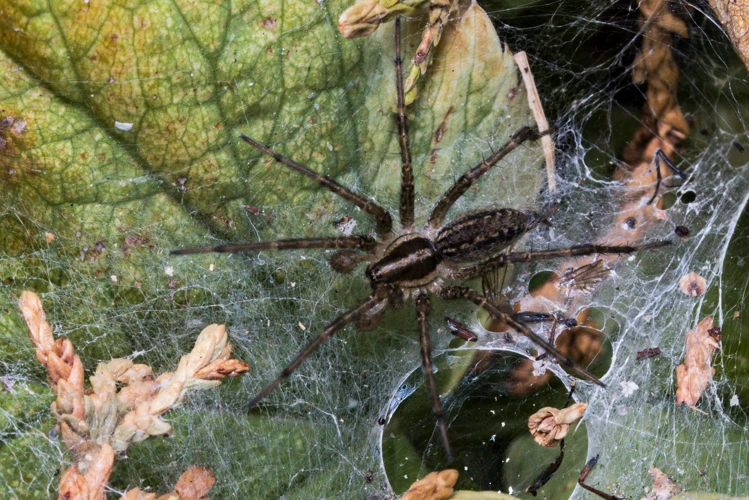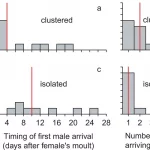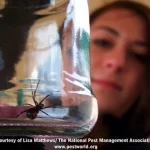Introduction

As farmers scan their fields during harvest season, they may notice the abundance of wolf spiders lurking among the crops. While some may feel apprehensive about these eight-legged creatures, others may wonder what has drawn them to agricultural land. The answer is multi-faceted, and the reasons behind this phenomenon are worth exploring. Let’s delve into the factors that attract wolf spiders to agricultural fields and how farmers can manage their spread.
Overview of Wolf Spiders in Agriculture
Wolf spiders are commonly found in agricultural fields where they play a significant role in the ecosystem. These spiders are members of the Lycosidae family and are known for their hunting abilities. They are typically medium to large-sized spiders, with females being larger than males, and are characterized by their remarkable eyesight. Wolf spiders are generally found on the ground, and they are capable of running fast, which makes them agile predators.
While some may view wolf spiders as pests, they are in fact beneficial to agriculture. They help control the population of harmful pests such as aphids, caterpillars, and beetles. They contribute to soil health by aerating it as they burrow. Wolf spiders are an essential component of the agricultural ecosystem that helps maintain the balance.
Understanding the habits and behavior of wolf spiders is crucial in comprehending how they thrive in agricultural fields. Contrary to the beliefs of many, these spiders are not nocturnal. They are active during the day and are most common during the spring and summer months when temperatures are favorable.
Wolf spiders are adapted to living in a variety of habitats, including fields, meadows, forests, and deserts. They are particularly common in croplands that are left undisturbed for extended periods. These spiders prefer to live in areas with a lot of vegetation, as it provides cover for them and their prey.
In the next sections, we will explore some of the factors that attract wolf spiders to agricultural fields. By understanding these factors, it will be possible to determine how to manage their populations effectively while still preserving their important role in the ecosystem.
Factors that Attract Wolf Spiders

It is perplexing for many farmers to find an abundance of wolf spiders in their agricultural fields since these spiders are known for their fondness of undisturbed forests and grasslands. However, several factors attract wolf spiders to these farms. Low pesticide use and undisturbed ground are just a few of the alluring conditions that make these agricultural fields an appealing habitat for wolf spiders. Their abundant prey, the availability of vegetation, and the open landscapes in these fields also contribute to the thriving populations of wolf spiders. In the next sections, we will delve into each of these factors and understand what makes agricultural fields so attractive to these arachnids.
Abundance of Prey
Wolf spiders are known for their predatory behavior and their diet consists of a wide range of insects including grasshoppers and caterpillars, which are commonly found in agricultural fields. The abundance of prey in these fields is one of the main reasons why wolf spiders are frequently found in such environments. They are opportunistic predators that capitalize on the abundance of insects in these habitats. Some of the common prey insects for wolf spiders in agricultural fields include aphids, cucumber beetles, and leafhoppers among others.
Wolf spiders are also known for their ability to adapt to different environmental conditions. This is one of the main reasons why they have made agricultural fields their preferred habitat. Due to high population densities of prey species, the wolf spiders in these fields tend to be larger in size and more active than their counterparts in other habitats.
Additionally, the lack of natural predators in these fields contributes to the abundance of wolf spiders. Human activity and the use of pesticides also reduce the presence of natural predators that would otherwise prey on the spiders and control their population. This, in turn, allows the population of wolf spiders to thrive and grow, further contributing to their abundance in agricultural fields.
It is important to note that while the abundance of prey in agricultural fields is a contributing factor to the presence of wolf spiders, this is not the only the factor. Other factors such as low pesticide use and open landscapes also contribute to their abundance in these habitats. Factors such as climate change and rarity also affect the population of wolf spiders in different habitats.
Low Pesticide Use
Studies have shown that the low use of pesticides in agricultural fields may be a contributing factor to the abundance of wolf spiders. Wolf spiders belong to the Lycosidae family and they are known for their fast running ability and their ability to jump on their prey and kill them with venom. They are also known to be resistant to some pesticides that are regularly used in agriculture fields.
The main reason for the low pesticide use is a shift towards natural methods of pest control. Farmers are aware that pesticides can be harmful to the environment and can affect human health. Instead, they are opting for alternative methods like biological control, crop rotation and using pest-resistant varieties of crops. This shift has made the agricultural environment more favorable for wolf spiders.
According to a study by Schmidt and Schafer, wolf spiders were more abundant in fields with reduced pesticide use as compared to fields where pesticides were heavily used. This is because low pesticide use creates a favorable environment for wolf spiders to thrive. Wolf spiders feed on smaller insects like aphids, mites, and caterpillars which are abundant in agricultural fields.
The low pesticide use also disrupts the natural predator-prey interactions because pesticides reduce the number of prey species available for wolf spiders to feed on. Wolf spiders are also resistant to some pesticides that are used to control insect populations.
Reducing pesticide use also has wider implications for the larger ecosystem. Pesticides can have a negative impact on other beneficial organisms like bees, birds, and other insects. The use of pesticides also poses a threat to the environment by contaminating soil and water.
Reducing pesticide use is a win-win situation for both farmers and the environment. It not only promotes the growth and development of wolf spiders, but it also benefits the larger ecosystem by reducing the harmful impacts of pesticides.
| Factors Leading to Abundance of Wolf Spiders in Agricultural Fields | Relevant Anchor |
| Increase in prey populations | Factors Leading to Rarity of Wolf Spiders |
| Low Pesticide Use | No relevant anchor in the text |
| Undisturbed ground | The Impact of Human Activity on Wolf Spiders |
| Open landscapes | The Effect of Habitat on Wolf Spider Abundance |
| Availability of vegetation | Climate Change and its Impact on Wolf Spiders |
Undisturbed Ground
Wolf spiders are known to thrive in areas where the ground remains undisturbed. This means that agricultural fields that undergo less tillage provide a perfect habitat for these spiders. Their preference for undisturbed ground can be attributed to the fact that it allows them to build their burrows without being disrupted or destroyed. Burrows built in undisturbed ground are typically deeper, providing better insulation and protection for the egg sacs and spiderlings.
Moreover, undisturbed ground also offers a stable source of moisture which wolf spiders require to survive. The presence of organic matter and vegetation helps to retain moisture, which in turn attracts various insects and pests that the spiders prey on.
Interestingly, studies have shown that wolf spiders are more abundant in no-till farming systems when compared to conventional tillage methods. This is because conventional tillage methods tend to disturb the ground, creating an unstable environment for the spiders to inhabit. On the other hand, no-till farming provides an ideal environment for wolf spiders to thrive due to minimal soil disturbance.
It is clear that undisturbed ground plays a significant role in attracting and maintaining wolf spider populations in agricultural fields. By promoting no-till farming practices and minimizing soil disturbance, farmers can take advantage of the benefits that these spiders provide in terms of natural pest control and biodiversity.
Open Landscapes
Open landscapes are another factor that encourages the abundance of wolf spiders in agricultural fields. Wolf spiders like open areas and are often found in fields, meadows, and grasslands. They prefer to be in areas where there’s no overhead vegetation or cover.
Reason: One reason for this could be that open landscapes provide wolf spiders with a better chance to hunt and locate their prey. When there’s no overhead vegetation or cover, wolf spiders can easily detect their prey without any obstacles. Another reason could be that open landscapes have higher temperatures, which wolf spiders prefer.
Open landscapes offer a larger hunting range for wolf spiders. They can move around freely and pursue their prey without running into obstacles. This freedom of movement allows them to be more effective hunters.
Finally, open landscapes provide an ideal environment for wolf spiders to establish their burrows. These burrows serve as shelters for wolf spiders, providing them with protection from predators and other environmental factors.
To summarize, open landscapes facilitate the growth and abundance of wolf spiders in agricultural fields. This is due to the availability of a larger hunting range, freedom of movement, ideal temperatures, and the opportunity to establish burrows. Farmers should keep this in mind when planning their agricultural fields and consider ways to manage the open landscapes in order to better control wolf spider populations.
| Reasons for Open Landscapes Encouraging Abundance of Wolf Spiders |
|---|
| Availability of a larger hunting range |
| Freedom of movement for effective hunting |
| Higher temperatures |
| Opportunity to establish burrows as shelters |
Availability of Vegetation
The availability of vegetation in agricultural fields plays a significant role in the abundance of wolf spiders. These spiders are known to thrive in areas with dense vegetation cover, such as crop fields with lush foliage. Vegetation not only provides shelter and hiding places for wolf spiders, but it also attracts their prey, such as insects and small rodents.
Agricultural fields that have abundant vegetation cover are more likely to have higher populations of wolf spiders.
Wolf spiders are known to prefer areas with diverse vegetation, including grasses, legumes, and broadleaf plants. This is because diverse vegetation can support a more significant number of prey species that wolf spiders feed on.
To provide a conducive environment for wolf spiders to thrive, farmers can encourage the growth of diverse vegetation in their fields. They can also introduce cover crops or intercropping methods that promote the growth of different types of plants.
Here are some examples of vegetation that can help attract wolf spiders to agricultural fields:
- Red clover
- Soybeans
- Wheat
- Alfalfa
By incorporating these types of vegetation into their fields, farmers may be able to maintain a healthy population of wolf spiders that can help control pests and maintain biodiversity. However, it’s important to note that excessively dense vegetation may also provide hiding spots for pests, so farmers need to balance the benefits of vegetation with effective pest control strategies.
The availability of diverse vegetation in agricultural fields is a key factor in promoting the abundance of wolf spiders, which can benefit farmers by naturally controlling pests.
Ways to Control Their Spread

Undoubtedly, the abundance of wolf spiders in agricultural fields can cause concern among farmers and agricultural experts. While these arachnids are known to provide natural pest control, their negative impacts on crop yields cannot be ignored. Fortunately, there are several ways to control the spread of wolf spiders in agricultural fields. In this section, we will explore some effective methods for reducing wolf spider populations and mitigating their damage. Let’s take a closer look at the strategies that can help farmers protect their crops without harming the environment or disrupting the ecosystem.
Use of Chemical Pesticides
Chemical pesticides have been widely used in agriculture for many years to control the population of harmful pests, including wolf spiders. However, the use of chemical pesticides is considered to have negative environmental impacts, which has led to a shift towards more sustainable pest control methods. Despite the drawbacks, chemical pesticides remain an effective way to limit the spread of wolf spiders in agricultural fields. Here are some details about how chemical pesticides can be used:
1. Identification of infested areas: Before using chemical pesticides, it is crucial to identify the affected areas where wolf spider populations are high. This helps target the application of pesticides, making them more effective in controlling the spider population and reducing the risk of harming non-target species.
2. Selection of the right pesticide: There are many types of chemical pesticides available on the market, each with specific active ingredients and methods of application. It is important to choose a pesticide that is effective against wolf spiders but not harmful to beneficial insects and other non-target species.
3. Application: Chemical pesticides can be applied to the infested areas in different ways, such as through sprays, dusts, and baits. The application method should be chosen carefully, depending on the environment and the severity of the infestation.
4. Safety precautions: It is essential to follow safety precautions when using chemical pesticides. This includes wearing protective clothing, avoiding contact with the skin and eyes, and storing them properly. Overuse of pesticides can also lead to the development of pesticide resistance in wolf spiders, which can make them more difficult to control in the future.
The use of chemical pesticides can effectively control the spread of wolf spiders in agricultural fields. However, it is important to consider the potential environmental impacts of their use and to take appropriate safety precautions. Additionally, it is recommended to use chemical pesticides in conjunction with other pest control methods to promote a more holistic and sustainable approach to pest management.
Introduce Predator Species
One effective way to control the spread of wolf spiders in agricultural fields is by introducing predator species. This method involves adding natural predators of wolf spiders to the environment, which helps to regulate their population and keep them in check.
Benefits of Introducing Predator Species
Introducing predator species can be a highly effective way to control wolf spider populations in agricultural fields. Some of the benefits of using this method include:
| Benefits | Explanation |
| Environmentally friendly | Unlike chemical pesticides, introducing predator species does not harm the environment. It also does not leave any harmful residues on crops or in the soil. |
| Natural | Using predator species is a natural way to control wolf spider populations. |
| Effective | Predator species are highly effective at controlling wolf spider populations, as they are natural enemies of the spider and can feed on them regularly. |
The Types of Predator Species used to Control Wolf Spiders
There are different types of predator species that are commonly used to control wolf spider populations. Some of these include:
- Birds of prey: There are many species of birds of prey that prey on wolf spiders, such as hawks and owls.
- Ground beetles: Ground beetles are a natural predator of wolf spiders and can be found in many agricultural fields.
- Praying mantis: Praying mantises are a natural enemy of wolf spiders and can be used to control their population in agricultural fields.
Limitations of Using Predator Species
While introducing predator species can be an effective way to control wolf spider populations in agricultural fields, there are also some limitations to using this method. Some of these limitations include:
| Limitations | Explanation |
| Time-consuming | Introducing predator species can be a time-consuming process, as it requires identifying the right species and introducing them into the environment. |
| May Not Be Feasible | In some cases, it may not be feasible to introduce predator species. For example, certain areas may not have the right environment to support certain species of birds or beetles. |
| May Not Be Effective | While predator species can be highly effective at controlling wolf spider populations, there is always a chance that they may not be effective in a particular environment. |
Conclusion
Introducing predator species is an effective and natural way to control the spread of wolf spiders in agricultural fields. While there are some limitations to using this method, when done correctly, it can be highly effective at controlling wolf spider populations without causing harm to the environment or crops.
Mechanical and Physical Control Measures
In addition to using chemical pesticides and introducing predator species, mechanical and physical control measures can be implemented to control the spread of wolf spiders in agricultural fields. These methods involve physically removing or blocking access to areas where wolf spiders are likely to reside.
Here are some examples of mechanical and physical control measures that can be effective in reducing the wolf spider population in agricultural fields:
- Exclusion barriers: A physical barrier such as a mesh or net can be placed around the perimeter of the field or around individual crops to prevent wolf spiders from entering.
- Trapping: Traps can be set up in areas where wolf spiders are often found. These traps can be baited with food or pheromones to attract the spiders. Once the spiders are trapped, they can be removed from the field.
- Cultural control: Changing the practices used in the field can help to reduce the population of wolf spiders. For example, reducing irrigation can help to reduce the moisture levels in the soil, which wolf spiders require for survival.
- Vacuuming: In areas where wolf spiders are frequently observed, a vacuum can be used to collect the spiders and their eggs.
- Harvesting: The use of mechanical harvesting equipment can disrupt the habitats of wolf spiders and reduce their population.
It’s important to note that mechanical and physical control measures can be time-consuming and labor-intensive. However, they can be effective alternatives to chemical pesticides and can provide a more sustainable solution to controlling the spread of wolf spiders in agricultural fields.
A combination of control measures may be most effective in managing the wolf spider population in agricultural fields. By implementing a variety of methods and taking a proactive approach to pest control, farmers can help to preserve the health of their crops while minimizing the impact on the environment.
Reduce Moisture Levels
One effective way to control the spread of wolf spiders in agricultural fields is by reducing moisture levels. Wolf spiders are known to prefer damp environments and reducing the amount of moisture in the soil can help deter them from inhabiting the area.
Mechanism of Action
Moisture reduction is an effective spider control measure because it reduces the availability of habitat suitable for the spiders to thrive. Wolf spiders require moist soil to burrow and lay their eggs. By reducing the moisture content, the soil can become less suitable for their survival.
Techniques to Reduce Moisture Content
There are several techniques that farmers can use to reduce moisture levels in agricultural fields. These include:
| Technique | Description |
|---|---|
| Proper Irrigation | Ensure proper and even irrigation management of the field to avoid overwatering and water stagnation in certain areas. |
| Improving Drainage | Drain waterlogged areas of the field by digging ditches or channels to facilitate water movement. |
| Cultivation Practices | Avoid deep tillage practices to reduce soil compaction and to maintain the soil structure that will help water to penetrate easily. |
Benefits of Moisture Reduction
Reducing moisture levels not only helps control the spread of wolf spiders, but it also has other benefits for agriculture. Excess moisture in soil can encourage the growth of plant diseases, fungus, and other pests. By reducing moisture levels, crops are less likely to develop diseases and rot which can lead to significant yield losses.
Conclusion
Reducing moisture content is a simple and effective way to control the spread of wolf spiders in agricultural fields. By properly managing irrigation, improving drainage, and practicing good cultivation methods, farmers can create an environment less conducive to the survival of wolf spiders. Additionally, the reduction of moisture levels can have other benefits such as reducing the risk of plant diseases and pests.
The Benefits of Wolf Spiders in Agriculture
As much as we may fear the spider, some of these eight-legged creatures are actually beneficial to agricultural ecosystems. Wolf spiders, in particular, are known to provide several benefits when it comes to controlling pest populations and promoting biodiversity. Though often overlooked and feared, wolf spiders are an essential asset to the agricultural fields they inhabit. Let’s explore the ways in which these arachnids contribute positively to their environment.
Natural Pest Control
One of the benefits of having wolf spiders in agricultural fields is that they provide natural pest control. These spiders are known for their voracious appetites and can consume a variety of pest insects, including aphids, beetles, and grasshoppers. This makes them an effective and organic means of managing pest infestations that can damage crops and reduce yields.
Studies have shown that the presence of wolf spiders in fields can reduce pest populations by up to 64%. Their ability to control pest populations is particularly beneficial for organic farmers who avoid using chemical pesticides to protect their crops.
Wolf spiders are skilled hunters and prefer to hunt at night, making them useful for controlling pests that are active during this time. They are also mobile and can quickly move to different areas of the field, allowing them to target pest populations wherever they occur.
In addition to their effectiveness in controlling pest populations, wolf spiders also have the advantage of being a natural and sustainable method of pest control. Instead of relying on chemical pesticides that can harm other beneficial insects and accumulate in the environment, wolf spiders are part of a natural ecological balance within the agricultural ecosystem.
Some examples of pests controlled by wolf spiders include:
- Aphids
- Mites
- Caterpillars
- Beetles
- Grasshoppers
Natural pest control provided by wolf spiders can be an important tool for farmers to maintain healthy crop yields while minimizing the use of harmful chemical pesticides.
Contributes to Biodiversity
Wolf spiders play a crucial role in maintaining biodiversity in agricultural fields. These spiders help control the population of small insects which, if left unchecked, can pose a significant threat to the agricultural ecosystem. This not only benefits the agricultural productivity but also ensures a healthy and balanced ecosystem. Let’s take a closer look at the ways in which wolf spiders contribute to biodiversity:
| Increased Prey Diversity | Reduction in Competition |
|---|---|
| As wolf spiders feed on a variety of insect species, their presence increases the overall diversity of prey in the agricultural fields. This not only benefits the predator species but also ensures a stable and healthy ecosystem. | With the presence of wolf spiders as natural predators, there is a decrease in competition for food among insect species. This leads to a more balanced and harmonious agricultural ecosystem. |
The presence of wolf spiders has been found to attract other predator species such as birds, reptiles, and other insects. This increase in predator diversity offers additional benefits to the agricultural ecosystem. For instance, birds are essential pollinators, whereas reptiles such as lizards help control the population of small rodents.
The presence of wolf spiders in agricultural fields contributes significantly to the overall maintenance of biodiversity. As natural predators, they help maintain a healthy and sustainable ecosystem, ensuring the continuing productivity of agricultural fields.
Conclusion
In conclusion, the abundance of wolf spiders in agricultural fields is the result of various factors, including the availability of prey, low pesticide use, undisturbed ground, open landscapes, and vegetation. While the presence of these spiders can be alarming to farmers, it’s important to note that they actually bring benefits to the field. These spiders provide natural pest control, which ultimately leads to higher crop yields by reducing the prevalence of damaging insects. Additionally, wolf spiders contribute to biodiversity by serving as an important food source for other animals.
While wolf spiders can be controlled through the use of chemical pesticides, introducing predator species, and implementing mechanical or physical control measures, these control methods can be harmful to other beneficial organisms and may not be sustainable in the long term. Therefore, it’s important to carefully consider the impact of any control method before implementing it in the field.
Overall, the abundance of wolf spiders in agricultural fields should be recognized as a sign of a healthy ecosystem, rather than solely as a pest problem. By understanding the factors that attract wolf spiders and their benefits to agriculture, farmers can better manage their fields and maximize their crop yields while also promoting ecological sustainability.
Frequently Asked Questions
What are wolf spiders?
Wolf spiders are a type of ground-dwelling spider that are known for their incredible speed and hunting abilities.
Why are wolf spiders so prevalent in agricultural fields?
There are several factors that make agricultural fields a perfect habitat for wolf spiders, including the abundance of prey, low pesticide use, undisturbed ground, open landscapes, and the availability of vegetation.
What is the main source of food for wolf spiders in agricultural fields?
Wolf spiders feed on a variety of small insects and arthropods, including grasshoppers, crickets, beetles, and caterpillars, making agricultural fields with a high density of such insects their ideal habitat.
How can pesticide use affect wolf spiders in agricultural fields?
While a low pesticide policy in agricultural fields might be conducive for wolf spiders, high pesticide use can be detrimental as it could lead to the spread of resistant and pesticide-tolerant species.
Can wolf spiders be harmful to humans?
Generally, wolf spiders are not harmful to humans and are not aggressive unless threatened. While their bite can cause local swelling and redness, it is usually not dangerous and does not require medical attention.
What are the different ways to control wolf spiders in agricultural fields?
Wolf spiders’ population can be controlled through the use of chemical pesticides, the introduction of predator species that feed on them, mechanical and physical control measures, and reducing moisture levels in the soil.
What are the drawbacks of using chemical pesticides to control wolf spiders?
The widespread use of chemicals can lead to the emergence of pesticide-resistant populations, harm non-target organisms, and lead to long-term environmental and health risks.
What are some of the benefits of wolf spiders in agricultural fields?
Wolf spiders are known as effective natural pest control agents, and their presence can contribute to the overall biodiversity of the agroecosystem.
What are some of the predator species that can be introduced to control wolf spiders?
Predator species that can be introduced into agricultural fields to control wolf spiders include birds, lizards, and even other spider species.
How can farmers strike a balance between controlling wolf spiders and preserving their benefits?
Farmers can strike a balance between controlling wolf spider populations and preserving their benefits by using integrated pest management approaches and minimizing their reliance on chemical pesticides.






